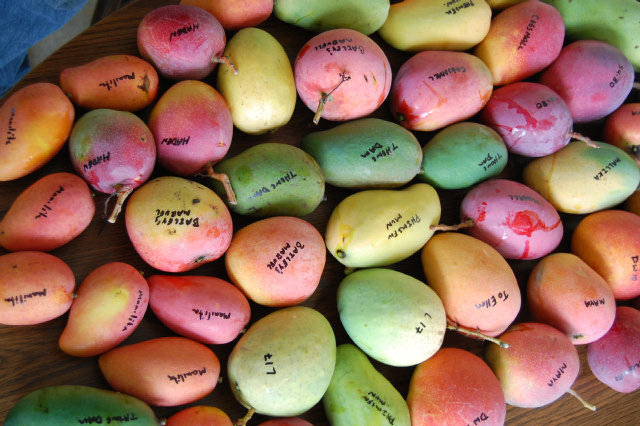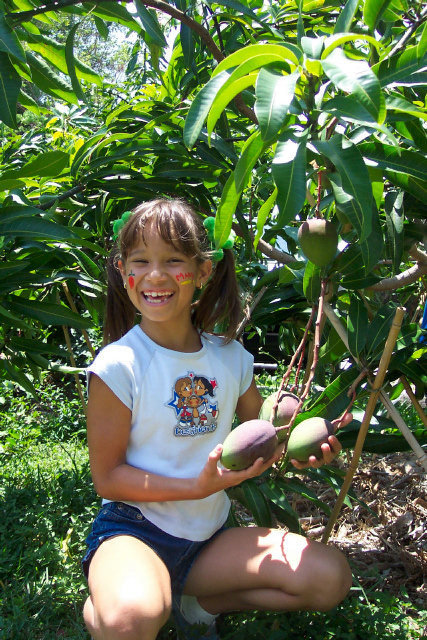From Fairchild Tropical Botanic Garden
by Noris Ledesma Curator of Tropical Fruit
Many Choices Now for Your Back Yard Mango Tree
As published in the Miami Herald
South Florida is one of the few mainland areas of the United States
in which the delicious and fragrant mango can be properly grown. For
years they have been of great value in South Florida. Grown with pride
in the garden, they are eaten as fruit when ripe and as a vegetable
when green. Nothing compares to the delicacy of a fresh Cogshall or
Rosigold mango harvested directly from the tree.
Today we are
privileged to have mango varieties with superior flavor, disease
resistance, adaptability and flavor. These mangos, truly a new
generation, are best grown using advanced horticultural techniques like
selective pruning, size control and ultra-low water and fertilizer
input. And by choosing the right varieties you can extend the mango
season from May to September.
What is the best variety for South
Florida? Decades ago, there was but one answer to that question —
the Haden, a fiberless, colorful fruit from a tree that is,
unfortunately, very large, with fruit that is highly susceptible to the
fungus anthracnose.

Mature mangos mean summertime is here.
Today,
your choices are different, and you should plant as many varieties as
you have space for. There are many superior ones to choose from, many
of which are available in local nurseries. They will also be available
at Fairchild’s 20th annual International Mango Festival taking
place July 14-15.
The following trees represent a new wave of
superior fruit that are well adapted to South Florida and make a great
addition to any backyard.
San Felipe
is an eye-stopping beauty from western Cuba and has many
characteristics of the Haden. It is about 11/2 pounds, with a bright
yellow background color, an apple-red blush overlaid by a blanket of
white dots. The tree is vigorous and a consistent producer. The flesh
color is a deep yellow to orange and the flavor is rich, sweet and
spicy, one of the truly classic mango flavors of the world. San Felipe
is perfect for the home gardener in search of the taste of old Cuba,
and for bragging rights among neighbors.
Cogshall
was selected on Pine Island, Florida, for its small tree, good
production, eating quality and beauty. The fruit weigh from 10 to 18
ounces and are yellowish-orange, overlaid with a brilliant crimson
blush. The fiberless flesh has an excellent, spicy and aromatic flavor.
The fruit and trees have good tolerance to fungal diseases. The
Cogshall tree remains small and compact and with minimal pruning can be
maintained at a height and spread of six feet or less. Such a tree will
easily produce 30 to 40 pounds of fruit while retaining health and
vigor.

Mango varieties vary greatly in shape, size, color and flavor.
Rosigold
is a local selection of Southeast Asian heritage. It has a very early
season with the fruit ripening from middle to late March. It weighs 11
ounces and is a bright yellow, with crimson and red highlights on the
sun-exposed shoulders. The skin is thick, tender and adhesive to the
soft, melting, juicy, deep-orange flesh. The flavor is rich, aromatic
and sweet, with a hint of the Asian tropics. The tree is small,
manageable and highly productive. It often has a multi-harvest fruiting
season.
Neelum is a
South Indian dessert mango. The fruit weighs nine ounces and ripens
from middle to late August, considerably late in the season. It is
smooth-skinned and bright yellow upon ripening and has no blush. The
flesh is deep yellow or orange and has no fiber. It has a rich,
aromatic flavor that is overpowering to the unaccustomed palate. Neelum
is best eaten out-of-hand, or used as slices or cubes in mixed fruit
salads, as the firm flesh holds its shape. Neelum is a dwarf.

No matter what your age, the mango has the power to put a smile on your face.
Angie
was selected by Fairchild Tropical Botanic Garden for home garden and
estate agriculture in South Florida because of its compact growth,
disease tolerance and overall fruit quality. The fruit weighs almost a
pound, is oblong and saffron yellow with Indian orange blush on the
sun-exposed shoulders. The flesh is tangerine orange and without fiber
with a deep sweetness and sophisticated profile rich in apricot. The
disease tolerance is excellent, and given its early season it often can
be harvested before the rainy season. The tree is semi-dwarf and highly
manageable with annual pruning.
Jean Ellen
is the second Fairchild selection perfect for the home garden because
of its early season, heavy production and its multiple bearing habit.
The fruit is 10 to 11 ounces, oblong with a lemon yellow color. The
skin is smooth and with an opaque yellow flesh. The flavor is sweet of
tropical spice. The tree grows easily and is semi-dwarf and precocious.
The tree and fruit are moderately tolerant of disease. Typically, there
are multiple blooms during the year. The season is from April to June
in South Florida.
Fairchild
was selected by Dr. David Fairchild and his family in the early 1900s
in the Panama Canal Zone. The small, oblong fruit averages 10 ounces
and has lemon yellow skin at maturity in June and July. The juicy,
fiber-free flesh is deep orange and aromatic, with a rich, spicy
flavor. The tree and fruit are highly tolerant of disease and fruit
well under humid conditions, making it a natural for South Florida. The
tree is among the most ornamental of mangos, with its compact shape and
deep green color. It can be maintained at a height and spread of eight
feet or less, perfect for those with a modest-sized home garden.
Back to
Mango Page
|
|


